|
|
 |

Wine touring in the Pyrenees-Orientales department of southwest France is a treat for the senses, particularly the Roussillon region tucked into a 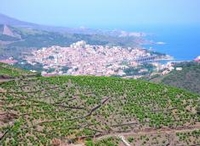 notch that opens to the Mediterranean to the east and a ring of mountains to the north, west and south. Coursing from the mountains, across a broad plain toward the sea, are three rivers that play a major role in the more than 54,000 acres of vineyards that cover the 13 Appellations d’Origine Controlee. The wineries of Roussillon are a fiercely proud part of France’s famed south coast and their wines are about to step onto the world stage. notch that opens to the Mediterranean to the east and a ring of mountains to the north, west and south. Coursing from the mountains, across a broad plain toward the sea, are three rivers that play a major role in the more than 54,000 acres of vineyards that cover the 13 Appellations d’Origine Controlee. The wineries of Roussillon are a fiercely proud part of France’s famed south coast and their wines are about to step onto the world stage.
Roussillon, of course, is not a new wine region in France. Fact is, vineyards in the part of southwest France now known as Roussillon were rooted by the Greeks as far back as the 7th century BCE. By the mid-17th century when the region became a part of France, Roussillon was subject to wars between the Kingdom of Majorca, France and Spain, and the resulting unsettling reality that helped shape the future character and commerce of Roussillon. Today, Roussillon is firmly in France, although it shares a border with the Catalonia region of Spain, allowing for a free exchange of customs, languages, cuisines and to some degree, wines.
Roussillon is different from other French wine regions in one distinct way. Dry white, rose and red table wines share the spotlight with Vins Doux Naturels, a special category of French wine made by mutage, a process that arrests fermentation by the addition of grape spirits, resulting in a sort of half-wine where the grape flavors dominate wine flavors. If Roussillon is known for any style of wine it is surely the sweet VDN wines. As delightful and interesting as VDN wines are, they will have to wait until a later column. This column will concentrate on Roussillon dry table wines, a subject that needs some explaining.
The owners of Roussillon wineries are acutely aware that burgeoning 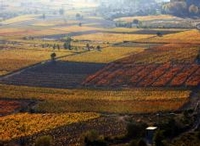 markets like the United States are where they need to be, but serving more than one master, dry table wines and sweet dessert wines can be difficult, especially if you want the consumer to look at your wines. During my recent four-day trip to Roussillon, I visited 13 wineries in five appellations and came away with the impressions that the Roussillon table wines I tasted were technically well-made, but also that many lacked the distinctive edge needed today to compete in an overcrowded U.S. market, even though some of the imported Roussillon wines are available in select markets. Moreover, most of the wines I tasted (with some notable exceptions) have a sameness that doesn’t set them apart from the hundreds of other wines available to consumers today at similar prices. markets like the United States are where they need to be, but serving more than one master, dry table wines and sweet dessert wines can be difficult, especially if you want the consumer to look at your wines. During my recent four-day trip to Roussillon, I visited 13 wineries in five appellations and came away with the impressions that the Roussillon table wines I tasted were technically well-made, but also that many lacked the distinctive edge needed today to compete in an overcrowded U.S. market, even though some of the imported Roussillon wines are available in select markets. Moreover, most of the wines I tasted (with some notable exceptions) have a sameness that doesn’t set them apart from the hundreds of other wines available to consumers today at similar prices.
There are a few factors controlling this situation, not the least being that Roussillon wines are overshadowed by those from other better-known regions in southern France, like Languedoc. In the public eye, the name Roussillon does not always stand on its own, but is usually appended to Languedoc, as in Languedoc-Roussillon, putting Roussillon second in the eyes of some consumers. Then there’s Provence, a region of southern France better known in the United States than Roussillon both as a tourist destination but also for its wines.
To those factors, add an unusual collection of white and red grapes 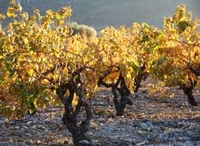 grown in Roussillon. Vermentino, a variety more popular in the dry white wines of Sardinia and Corsica stands out as a Roussillon white as do the few wines I tasted made from Roussanne and Marsanne, although these two grapes are better known in the Rhône Valley and not so widely grown in Roussillon. That leaves a pair of Muscats, Macabeu (a variety of Catalan origin) and a Sardinian grape called Malvoisie du Roussillon Blanche; try selling that name to language-challenged Americans. grown in Roussillon. Vermentino, a variety more popular in the dry white wines of Sardinia and Corsica stands out as a Roussillon white as do the few wines I tasted made from Roussanne and Marsanne, although these two grapes are better known in the Rhône Valley and not so widely grown in Roussillon. That leaves a pair of Muscats, Macabeu (a variety of Catalan origin) and a Sardinian grape called Malvoisie du Roussillon Blanche; try selling that name to language-challenged Americans.
Black grapes fare better in Roussillon and, overall, make more interesting wines. Syrah, Mourvedre, Grenache and Carignan yield wines with more character and substance. But my guess is that consumers looking for French Syrah and Grenache, will look to the Rhône Valley before Roussillon. Mourvedre and Carignan are Spanish in origin where they are known as Monastrell and Cariñena, respectively. That leaves Cinsault, more typically seen in Provence and Languedoc and a local variety with the unpronounceable name of Ladoner Pelut.
There is a little action in Roussillon with highly favored international varieties like Chardonnay and Cabernet Sauvignon, but the bulk of Roussillon table wines are made mostly from second-tier grapes. Of course, it can be argued that a collection of unique local grapes is what gives Roussillon table wines their charm and uniqueness, something that believers like the owners of Domaine Terloar are avidly promoting. Maybe, but carving out a niche for unfamiliar wines is hard work, especially when faced with the reality that consumers are more comfortable with wines made from top-tier grapes like Cabernet Sauvignon and Sauvignon Blanc.
One more controlling factor: Terroir and the influence of particular soils, 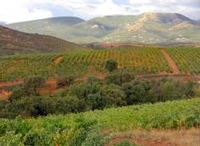 which was a subject I heard mentioned often in Roussillon, but found very hard to smell or taste in the wines. Terroir is a French concept that is difficult to define, but even more difficult to detect in a wine, mainly because in most cases winemaking gets in the way. Terroir can also be an indicator of regionality or character, a concept that many wineries use to distinguish their wines from those of other regions, such as the schist-based soils of Roussillon. Perhaps it is the broad meaning of terroir that allows for the differences between a Cabernet-based Medoc and a Napa Valley Cabernet Sauvignon, but I can only say that despite all of the talk about soils and the larger concept of terroir by Roussillon winemakers, I struggled to pin any differences I tasted in the wines to terroir or soils and I suspect the consumer will as well. which was a subject I heard mentioned often in Roussillon, but found very hard to smell or taste in the wines. Terroir is a French concept that is difficult to define, but even more difficult to detect in a wine, mainly because in most cases winemaking gets in the way. Terroir can also be an indicator of regionality or character, a concept that many wineries use to distinguish their wines from those of other regions, such as the schist-based soils of Roussillon. Perhaps it is the broad meaning of terroir that allows for the differences between a Cabernet-based Medoc and a Napa Valley Cabernet Sauvignon, but I can only say that despite all of the talk about soils and the larger concept of terroir by Roussillon winemakers, I struggled to pin any differences I tasted in the wines to terroir or soils and I suspect the consumer will as well.
These factors are what I found fascinating and challenging about Roussillon table wines. However, my job is to be an observer and commentator--not a problem solver. If regional character and soils are the things that set Roussillon apart from other wines, then this needs to be better illustrated and not just presented to the taster as a matter of faith. A stronger emphasis on fresher red wines and more interesting blends of local varieties with the few international grapes available would also help.
The most distinctive Roussillon table wines I tasted during my visit were from the appellations Côtes du Roussillon Villages and Collioure. Côtes du Roussillon Villages is a broad appellation that covers most of the region, except for the small Collioure appellation that borders Spanish Catalonia. Côtes du Roussillon Villages wines can be either rose, red or white, such as the tasty Domaine des Schistes Terrasses Blanche 2009, a blend of Grenache Blanc, Grenache Gris and Macabeu.
The single appellation, Cotes du Roussillon les Aspres, is only red as are the wines carrying the Cotes du Roussillon Villages (CRV) name. These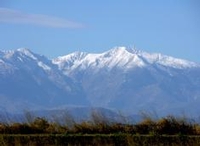 reds mainly follow the familiar GSM (Grenache-Syrah-Mourvedre) blend, although some of the blends are Grenache Noir, Syrah and Carignan and a few are single varietals like Domaine Singla’s complex Bessol made from Grenache Noir. In all, I tasted 10 Côtes du Roussillon Villages that impressed me as balanced wines with depth and complexity. The standouts include Domaine Singla Castell Vell 2009, Domaine Singla El Moli 2008, Domaine Singla 2009 Bessol, Emile Cazes Alter 2007, Emile Cazes Ego 2009, Domaine des Schistes Tradition 2010, Domaine Treloar Tahi 2007 and Domaine de l’edre Carremont Rouge 2010. reds mainly follow the familiar GSM (Grenache-Syrah-Mourvedre) blend, although some of the blends are Grenache Noir, Syrah and Carignan and a few are single varietals like Domaine Singla’s complex Bessol made from Grenache Noir. In all, I tasted 10 Côtes du Roussillon Villages that impressed me as balanced wines with depth and complexity. The standouts include Domaine Singla Castell Vell 2009, Domaine Singla El Moli 2008, Domaine Singla 2009 Bessol, Emile Cazes Alter 2007, Emile Cazes Ego 2009, Domaine des Schistes Tradition 2010, Domaine Treloar Tahi 2007 and Domaine de l’edre Carremont Rouge 2010.
Collioure is known both for its lovely seaside towns Collioure and Port-Vendres, but also for vins deux naturel wines, a distinction it shares with Banyuls. Collioure red, white and rose table wines are not as well known but deserve more attention. Made from the same varieties as those used in Côtes du Roussillon Villages wines, there are a few Syrahs and Syrah-Grenache blends of note such as those from Christine Campadieu’s Domaine la Tour Vielle. Campadieu’s terraced vineyards are typical of the region with its hillside vineyards facing the Mediterranean. The first vintage for La Tour Vielle, named for an old stone watch tower on a hill behind the winery, was 1980 made by winemaker Vincent Cantie. His 2008 Pinede is a vibrant Syrah rosé with no oak and the 2008 Puig Criol, Syrah and Grenache Noir shows great depth and complexity. My favorite is La Tour Vielle 2009 Puig Amheille, a textured blend of Grenache and Mourvedre. Puig is a Catalan word for peak or top of the hill, a fitting choice for a wine made in French Catalonia. Also of note is Emile Cazes 2009 Collioure Notre Dame des Anges.
Not all of the wines mentioned above are in U.S. markets, but most are (or will be by the beginning of 2012). My next column will cover the unusual and tasty Vins Doux Naturel wines of Roussillion, so look for that here on WRO in late December.
* * *
Questions? Comments? Contact me at gboyd@winereviewonline.com
|
 |
|